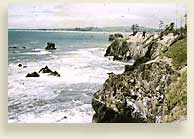Territorial Timeline

The first known Europeans set foot on Washington State soil
On July 14, 1775, Spanish explorers Bruno Heceta and Bodega y Quadra went ashore at what is now Point Grenville, near the Hoh River on the Olympic Peninsula of Washington, and became the first known white men to set foot on the soil of Washington State.
On May 21, 1775, Bruno Heceta, commanding the Spanish ship Santiago, sailed from San Blas, Mexico, accompanied by Bodega y Quadra commanding the thirty-six foot long schooner Sonora. Their instructions were to sail at least 65 degrees north. On July 14, 1775, Heceta and Quadra went ashore at what is now Point Grenville, near the Hoh River on the Olympic Peninsula of Washington. There they erected a cross and buried a wax-sealed bottle containing a record of the Spanish claim to the Pacific Northwest. This was the first documented instance of white men setting foot on the soil of Washington State.
While the ceremony was taking place the Sonora was anchored by a nearby island. Seven men under Quadra’s command went ashore to the island in search of wood and water. As they landed, Indians rushed out of hiding, killed the sailors, and began tearing the boat apart for its metal. Quadra was furious and wanted to lead a party in to punish the Indians but he was over-ruled by Heceta, the commander of the expedition. Before leaving, Quadra named the island Isla de Dolores or "Island of Sorrows." The name was later changed to Destruction Island.
Heceta and Quadra continued to sail north in the Santiago and the Sonora . They became separated in a storm on July 30, 1775. Quadra in the small schooner Sonora reached 58 degrees north, the latitude of Sitka, Alaska. On November 20, he safely returned to San Blas, Mexico. After the storm, Heceta returned to the Isla de Dolores and tried to catch the murderers of Quadra’s men, but the Indian village was deserted. Heceta continued south and discovered signs of a great river, but since his crew was suffering from scurvy, he was not able to stop and explore. If Heceta had, he would have discovered the Columbia River - the long-sought “River of the West.” He returned to Monterey, Mexico on August 29, 1775.